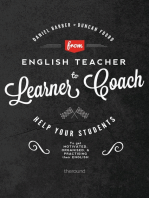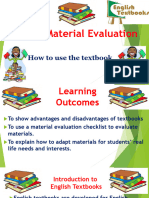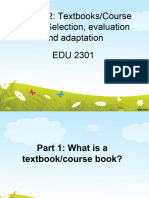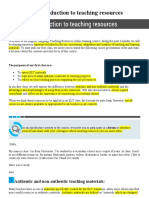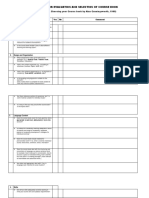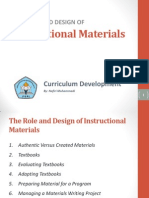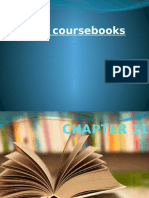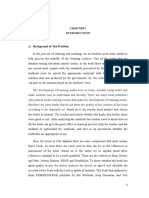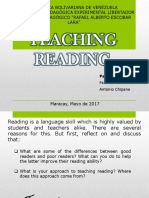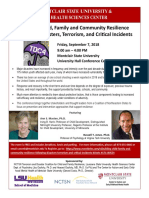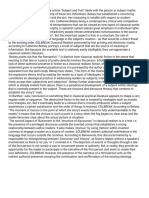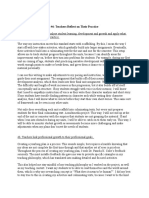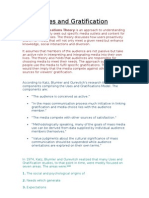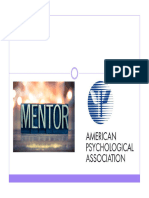0 ratings0% found this document useful (0 votes)
71 viewsArticle 1
Article 1
Uploaded by
Muhammad Faizfor fancy
Copyright:
© All Rights Reserved
Available Formats
Download as DOCX, PDF, TXT or read online from Scribd
Article 1
Article 1
Uploaded by
Muhammad Faiz0 ratings0% found this document useful (0 votes)
71 views7 pagesfor fancy
Original Title
article 1
Copyright
© © All Rights Reserved
Available Formats
DOCX, PDF, TXT or read online from Scribd
Share this document
Did you find this document useful?
Is this content inappropriate?
for fancy
Copyright:
© All Rights Reserved
Available Formats
Download as DOCX, PDF, TXT or read online from Scribd
Download as docx, pdf, or txt
0 ratings0% found this document useful (0 votes)
71 views7 pagesArticle 1
Article 1
Uploaded by
Muhammad Faizfor fancy
Copyright:
© All Rights Reserved
Available Formats
Download as DOCX, PDF, TXT or read online from Scribd
Download as docx, pdf, or txt
You are on page 1of 7
Unit 14 Evaluating and Adapting Textbooks
Aims of the unit:
In this unit we will discuss some basic things about textbook evaluation,
selection and adaptation. We will focus on the following:
1. Why and what do teachers evaluate and adapt?
2. How do teachers evaluate textbooks?
3. How do teachers evaluate textbooks?
4. How do teachers adapt textbooks?
14.1 Why and what?
With the rapid ELT development in China, more and more textbooks have
made their way to the market. Choosing the right textbook is becoming more and
more important at all levels of ELT in schools. With the effort from textbook
writers, ELT researchers and classroom teachers, textbook evaluation and selection
have evolved to systematic action. Although most classroom teachers will not be
involved in the production of textbooks, all teachers have the responsibility for
textbook evaluation, selection and adaptation. In this unit, we will introduce some
principles of textbook evaluation, selection, and adaptation.
So far we have been using the term textbook. However, the focus of this
unit is far more than just textbooks. Nowadays, textbooks in traditional pedagogy
have evolved into a great variety of resources used in language classroom such as
audio cassettes, videos, CD-ROMs, dictionaries, grammar book, readers,
workbook, teachers books, photocopied materials, flashcards, and other authentic
materials, such as newspaper, photographs, advertisements, radio/TV programs,
etc. In many cases the term materials is used in place of textbooks, which
refers to anything that is used by teachers or students to facilitate the learning of a
language. The term textbooks is still widely used, but its reference has expanded
from books to all the materials used around or independent of the books.
14.2 Evaluating textbooks
An ideal systematic textbook evaluation would be a longitudinal one, which
includes pre-use evaluation, whilst-use evaluation and post-use evaluation. The
core of systematic textbook evaluation is to examine how well a given textbook
matches the needs of a language program and how effectively and efficiently it can
realize the objectives of the program. Therefore needs analysis has to be done prior
to textbook evaluation. Due to space limitation, in this unit, we will focus on
general features of good textbooks and how to evaluate textbooks based on these
features.
Features of good textbooks: We believed good textbooks should have the
following features.
Good textbooks should attract the students curiosity, interest and attention. In
order to do this, textbooks should have novelty, variety, attractive layout,
appealing content, etc. Of course they should also make sure that learning
really takes place when the students use the textbooks. It is not necessarily
enough that students enjoy the textbooks.
Textbooks should help students to feel at ease. The layout of presentation,
tasks and activities, and texts and illustrations should all look friendly to the
students so that they fell relaxed when seeing them.
Textbooks should help students to develop confidence. Good textbooks help
to build up students confidence by providing tasks or activities that students
can cope with.
Textbooks should meet students needs. What is covered in the textbooks
should be relevant and useful to what the students need to learn and what they
want to learn.
Textbooks should expose the students to language in authentic use. Generally
speaking, textbooks written in authentic language are more motivating and
challenging.
Textbooks should provide the students with opportunities to use the target
language to achieve communicative purposes.
Textbooks should take into account that the positive effects of language
teaching are usually delayed. Research into SLA shows that it is a gradual
rather than an instantaneous process and that this is equally true for instructed
learning. So it is important for textbooks to recycle instruction and to provide
frequent and ample exposure to the instructed language features in
communicative use.
Textbooks should take into account that students differ in learning styles.
Tasks and activities should be variable and should cater for a range of
learning styles so all students can benefit.
Textbooks should take into account that students differ in affective factors.
Good textbooks should accommodate different attitudinal and motivational
background as much as possible.
Textbooks should maximize learning potential by encouraging intellectual,
aesthetic and emotional involvement which stimulates both right and left
brain activities. Good textbooks enable the students to receive, process and
retain information through multiple intelligences.
14.3 Selecting textbooks
Some people think evaluation and selection are more or less the same thing.
After all, we select after we evaluate. However, evaluating textbooks is one thing,
selecting textbooks is quite another. For instance, when we evaluate a textbook
without an intention to use it for a certain group of students, we try to examine
whether what is covered in the book can really fulfill the original purposes of the
writer of the book. In another word, is the book really suitable for the learners for
whom the book is intended?
When we evaluate a textbook with an intention of adoption, we try to match
what is offered by the book with the needs of our language program. However, this
is no easy job for the teachers. For one thing, teachers may be overwhelmed by the
rich contents of the book, which usually has several volumes. For another, teachers
do not always have a clear awareness of what their students need. In order to make
the job of textbook selection easier, materials researchers have developed several
practical and operational checklists for classroom teachers.
Grant designed a three-part questionnaire which can be used as a checklist
when teachers select textbooks for their students. Basically the questionnaire helps
teachers to examine the extent to which a textbook suits the students, the teacher
and the syllabus and examination:
Choosing a textbook: questionnaire (part 1)
Does the book suit your students?
1 Is it attractive? Given the average YES PARTLY NO
age of your students, would they
enjoy using it?
2 Is it culturally acceptable? YES PARTLY NO
3 Does it reflect what you know YES PARTLY NO
about your students needs and inter-
ests?
4 Is it about the right level of difficulty? YES PARTLY NO
5 Is it about the right length? YES PARTLY NO
6 Are the courses physical characteris- YES PARTLY NO
tics appropriate? (e.g. is it durable?)
7 Are there enough authentic materials, YES PARTLY NO
so that the students can see that the book
is relevant to real life?
8 Does it achieve an acceptable balance YES PARTLY NO
between knowledge about the language,
and practice in using the language?
9 Does it achieve an acceptable balance YES PARTLY NO
between the relevant language skills, and
integrate them so that work in one skill
area helps the others?
10 Does the book contain enough communi- YES PARTLY NO
cative activities to enable the students to
use the language independently?
Score: 2 points for every YES answer.
1 point for every PARTLY answer.
0 for every NO answer.
Choosing a textbook: questionnaire (part 2)
Does the book suit the teacher?
1 Is your overall impression of the contents YES PARTLY NO
and layout of the course favorable?
2 Is there a good, clear teachers guide with YES PARTLY NO
answers and help on methods and additional
activities?
3 Can one use the book in the classroom with- YES PARTLY NO
out constantly having to turn to the teachers
guide?
4 Are the recommended methods and appro- YES PARTLY NO
aches suitable for you, your students and
your classroom?
5 Are the approaches easily adaptable if YES PARTLY NO
necessary?
6 Does using the course require little or no YES PARTLY NO
time-consuming preparation?
7 Are useful ancillary materials such as tapes YES PARTLY NO
workbooks, and visuals provided?
8 Is there sufficient provision made for tests YES PARTLY NO
and revision?
9 Does the book use a spiral approach, so that YES PARTLY NO
items are regularly revised and used again in
different contexts?
10 Is the course appropriate for, and liked by, YES PARTLY NO
colleagues?
Score: 2 points for every YES answer.
1 point for every PARTLY answer.
0 for every NO answer.
Choosing a textbook: questionnaire (part 3)
Does the book suit the syllabus and examination?
1 Has the book been recommended or app- YES PARTLY NO
roved by the authorities?
2 Does the book follow the official syllabus YES PARTLY NO
in a creative manner?
3 Is the course well-graded, so that it gives YES PARTLY NO
well-structured and systematic coverage
of the language?
4 If it does more than the syllabus requires, YES PARTLY NO
is the result an improvement?
5 Are the activities, contents and methods YES PARTLY NO
used in the course well-planned and
executed?
6 Has it been prepared specifically for the YES PARTLY NO
target examination?
7 Do the courses methods help the stu- YES PARTLY NO
dents prepare for the exam?
8 Is there a good balance between what YES PARTLY NO
the examination requires, and what the
students need?
9 Is there enough examination practice? YES PARTLY NO
10 Does the course contain useful hints on YES PARTLY NO
examination technique?
Score: 2 points for every YES answer.
1 point for every PARTLY answer.
0 for every NO answer.
14.4 Adapting textbooks
Despite the great effort that textbook writers make to meet the needs of the
intended users, textbooks are subjective to adaptation when they are actually used
in the classroom. After all, most commercial textbooks are written for any
particular class. The following options are suggested to adapt materials:
omission: the teacher leaves out things deemed inappropriate, offensive,
unproductive, etc. for the particular group.
addition: where there seems to be inadequate coverage, teachers may decide to add
to textbooks, either in the form of texts or exercise material.
reduction: where the teacher shortens an activity to give it less weight or emphasis.
extension: where an activity is lengthened in order to give it as additional
dimension. (For example, a vocabulary activity is extended to draw attention
to some syntactic patterning.)
rewriting/modification: teacher may occasionally decide to rewrite material,
especially exercise material, to make it more appropriate, more
communicative, more demanding, more accessible to their students, etc.
replacement: text or exercise material which is considered inadequate, for
whatever reason, may be replaced by more suitable material. This is often
from other resource materials.
re-ordering: teachers may decide that the order in which the textbooks are
presented is not suitable for their students. They can then decide to plot a
different course through the textbooks from the one the writer has laid down.
branching: teachers may decide to add options to the existing activity or to
suggest alternative pathways through the activities. (For example, an
experiential route or an analytical route.)
Textbook adaptation can be done at three levels. The first level is macro
adaptation, which is ideally done before the language program begins. After
comparing what is covered in a textbook and what is required by the syllabus or
examination, the teacher may find that certain areas or even whole units of the
book can be omitted, and certain contents need to be supplemented. Macro
adaptation is very important because it helps the teacher to avoid waste if time and
every of the teacher and the students as well. It also helps the teacher to see in
advance what he or she needs to supplement so that he or she can keep an eye on
materials that could be used.
The second level of adaptation is adapting a unit. This could be reordering the
activities, combining activities, omitting activities, rewriting or supplementing
exercise material, etc. Unit adaptation helps to make the classroom teaching more
smooth and cohesive. It also helps the teacher to better fulfill the aims of a unit.
The third level is adaptation of specific activities in a unit. Occasionally an
activity I regarded as valuable, but it is not well-designed or it is not feasible in
particular class. If the teacher does not want to give up the activity, he or she needs
to adapt it.
Very often, adaptation involves supplementation, that is, teachers add
materials from other resources to the textbook they are using. It is believed that
authentic materials are better than non-authentic materials for supplementation. So
teachers who make a point of collecting authentic materials find it much easier to
adapt textbooks. This is especially true in ELT contents where authentic English
materials are not always readily to hand.
14.5 Conclusion
In this unit we have briefly talked about textbook evaluation, selection and
adaptation. The value of these actions is so obvious that no one would argue
against it. However, these actions can be done only when three conditions are met.
Firstly, teachers need to have the authority to evaluate, select and adapt
textbooks. In many cases, teachers are simply told to use a certain textbook. In
worse circumstances, teachers are told to use a book. Some teachers are even
criticized for intentionally leaving out activities that they do not consider
appropriate or necessary.
Secondly, teachers have to have the initiative to evaluate, select and adapt
textbooks. Very often, with a heavy workload, teachers simply do not have the
time or energy to do anything beyond lesson planning and making students
homework. Without explicit encouragement from authorities, many teachers do not
make an effort to evaluate and adapt textbooks.
Thirdly, teachers need to know how to evaluate, select and adapt textbooks.
At the time when this book is being written, very few ELT teacher education
programs in China offer specific training in materials evaluation and design, and
publications on ELT materials are hard to find. If textbook evaluation is ever done,
it is mostly impressionistic judgment based on experience or intuition. It is the
concern for this deplorable situation that made the authors incorporate this last unit
into a methodology book, which, in normal cases, would not touch the material
world.
In this unit, we did not specifically discuss textbook creation, though some
classroom teachers are already involved in it. However, most of the suggested
ideas about textbook evaluation and adaptation are also applicable to textbook
creation.
You might also like
- Northstar Internediate Answers KeyDocument1 pageNorthstar Internediate Answers KeyAli Alhaj100% (3)
- Project-Based Learning Applied to the Language ClassroomFrom EverandProject-Based Learning Applied to the Language ClassroomNo ratings yet
- Managing Change: Self-Assessment Questions and AnswersDocument7 pagesManaging Change: Self-Assessment Questions and AnswerswondimuNo ratings yet
- Bluest Eye LessonDocument1 pageBluest Eye Lessonapi-391214969No ratings yet
- Elt Textbooks Evaluation and Adaptation: Lingjuan MaDocument7 pagesElt Textbooks Evaluation and Adaptation: Lingjuan Mayuri231No ratings yet
- How To Evaluate TextbookDocument16 pagesHow To Evaluate TextbookDinar DiptaNo ratings yet
- An Evaluation of English Language Textbook Interla PDFDocument7 pagesAn Evaluation of English Language Textbook Interla PDFcarolina VallejoNo ratings yet
- Unit 11 Material Evaluation (How To Use Textbook)Document35 pagesUnit 11 Material Evaluation (How To Use Textbook)phoeurnsokphin46No ratings yet
- What Is A Textbook?Document19 pagesWhat Is A Textbook?Nora MohamedNo ratings yet
- Book Analysis: Dewi Diansari 2215081428Document5 pagesBook Analysis: Dewi Diansari 2215081428Dewi DiansariNo ratings yet
- Choosing A CoursebookDocument3 pagesChoosing A CoursebookNovitasari Sukatno PutriNo ratings yet
- Module in Educ.205Document17 pagesModule in Educ.205Melody Ann Abaya AngalaNo ratings yet
- PDFMB10000003 Choosing A CoursebookDocument3 pagesPDFMB10000003 Choosing A CoursebookAgustín EchevarríaNo ratings yet
- Factors Affecting The Choice of A TBDocument3 pagesFactors Affecting The Choice of A TBMed DjbaliNo ratings yet
- Criteria of A Good Textbook Based On The ExpertsDocument3 pagesCriteria of A Good Textbook Based On The ExpertsTea PotNo ratings yet
- Lecture 2 - Textbook - Course BookDocument46 pagesLecture 2 - Textbook - Course Bookvekelet399No ratings yet
- UAS Group 11 Textbook AnalysisDocument18 pagesUAS Group 11 Textbook AnalysisAnnisa Fitri zianNo ratings yet
- The Role of Textbooks in Language ProgramDocument6 pagesThe Role of Textbooks in Language ProgramBoujemaa Al MallamNo ratings yet
- Criteria of A Good Textbook Based On The ExpertsDocument4 pagesCriteria of A Good Textbook Based On The ExpertsAulia100% (1)
- TextbooksDocument3 pagesTextbooksAli FPNo ratings yet
- Coursebook EvaluationDocument32 pagesCoursebook EvaluationVindy Virgine GucciNo ratings yet
- Lesson 4 TKTDocument7 pagesLesson 4 TKTRICARDONo ratings yet
- Textbook Evaluation Criteria and SampleDocument3 pagesTextbook Evaluation Criteria and Samplemoumousa22No ratings yet
- Coursebook Analysis - Docx-2Document12 pagesCoursebook Analysis - Docx-2Nika NiksNo ratings yet
- Factual Details AutoguardadoDocument11 pagesFactual Details Autoguardadoapi-224695265No ratings yet
- Coursebook Evaluation TheoryDocument4 pagesCoursebook Evaluation TheorySanja Ilova100% (2)
- Coursebook Evaluation - Světlana HanušováDocument7 pagesCoursebook Evaluation - Světlana HanušováBozena TROMBLYNo ratings yet
- Textbooks Evaluation For Selection and Analysis For ImplementationDocument8 pagesTextbooks Evaluation For Selection and Analysis For ImplementationGapas Mary AnnNo ratings yet
- m3 The Roles of TextbookDocument3 pagesm3 The Roles of TextbookHải Trà NguyễnNo ratings yet
- Class 1. An Introduction To Teaching Resources: Authentic and Non-Authentic Teaching MaterialsDocument6 pagesClass 1. An Introduction To Teaching Resources: Authentic and Non-Authentic Teaching MaterialsanaNo ratings yet
- Final Escrito - Fundamentos de La E y A IIDocument3 pagesFinal Escrito - Fundamentos de La E y A IIAbril PaijeNo ratings yet
- Textbook Analysis DefinitionDocument12 pagesTextbook Analysis DefinitionLatifah Wayne100% (4)
- Checklist For Evaluation and Selection of Course BookDocument5 pagesChecklist For Evaluation and Selection of Course BookAbil AnugrahNo ratings yet
- The Role and Design of Instructional MaterialsDocument34 pagesThe Role and Design of Instructional MaterialsFiriMohammedi67% (3)
- Prelim Weeks 4 5 1Document44 pagesPrelim Weeks 4 5 1Rowell GuevaraNo ratings yet
- Criteria For Textbook EvaluationDocument2 pagesCriteria For Textbook Evaluationjanine100% (4)
- The 61 TEFLIN International Conference, UNS Solo 2014Document4 pagesThe 61 TEFLIN International Conference, UNS Solo 2014miftaNo ratings yet
- Textbook AnalysisDocument6 pagesTextbook AnalysisNuzhat TabassumNo ratings yet
- Lesson 4 and 5 Critique (Group 1)Document2 pagesLesson 4 and 5 Critique (Group 1)Jaytee TaquisoNo ratings yet
- 3Document3 pages3sumetNo ratings yet
- FS 1-2 Tasks DanDocument35 pagesFS 1-2 Tasks DanJerlyn Rjs DañosoNo ratings yet
- 2A-Lesson Planning-İsmail Can Turan 061810124Document9 pages2A-Lesson Planning-İsmail Can Turan 061810124goncaNo ratings yet
- Using CoursebooksDocument19 pagesUsing CoursebooksRaquel GonzalezNo ratings yet
- 15. Textbook-evaluation-1Document3 pages15. Textbook-evaluation-1MariaNo ratings yet
- 9 Mistakes To Avoid When TeachingDocument4 pages9 Mistakes To Avoid When TeachingSonsaku HakufuNo ratings yet
- English Module - Class XDocument258 pagesEnglish Module - Class XGovada VenkateswarluNo ratings yet
- FS - 1-2 - TASKS - DAÑOSO JERLYN FinalDocument53 pagesFS - 1-2 - TASKS - DAÑOSO JERLYN FinalJerlyn Rjs DañosoNo ratings yet
- Đào Thị Dung-ESP evaluation reportDocument12 pagesĐào Thị Dung-ESP evaluation reportlamthienphong13No ratings yet
- Choosing A Course BookDocument19 pagesChoosing A Course BookResmining IstigfarinNo ratings yet
- ActionDocument18 pagesActionojasvi gulyaniNo ratings yet
- Tsl3113 Using Resources For The Esl ClassDocument10 pagesTsl3113 Using Resources For The Esl ClassJonathon MoranNo ratings yet
- Intensive and Extensive ReadingDocument31 pagesIntensive and Extensive ReadingSelçuk AktüreNo ratings yet
- Group 1 - 19SPA01 - Mid-Term AssignmentDocument13 pagesGroup 1 - 19SPA01 - Mid-Term AssignmentKim ThảoNo ratings yet
- Module 5, Evaluating and Adapting Coursebook, TextbookDocument18 pagesModule 5, Evaluating and Adapting Coursebook, Textbookjhjm0805snsdNo ratings yet
- Coursebook EvaluationDocument14 pagesCoursebook EvaluationMariaNo ratings yet
- Planning 1Document8 pagesPlanning 1Слободан Драгана ПоповићNo ratings yet
- Paper FixDocument53 pagesPaper FixayuniNo ratings yet
- The Teacher As CurricularistDocument6 pagesThe Teacher As CurricularistMicah GuinucudNo ratings yet
- República Bolivariana de Venezuela Universidad Pedagógica Experimental Libertador Instituto Pedagógico "Rafael Alberto Escobar Lara"Document23 pagesRepública Bolivariana de Venezuela Universidad Pedagógica Experimental Libertador Instituto Pedagógico "Rafael Alberto Escobar Lara"patrocia19No ratings yet
- You Raise Me UpDocument2 pagesYou Raise Me UpMuhammad FaizNo ratings yet
- Daily Lesson Plan: Choose An ItemDocument20 pagesDaily Lesson Plan: Choose An ItemMuhammad FaizNo ratings yet
- PinocchioDocument2 pagesPinocchioMuhammad FaizNo ratings yet
- A Sailor Went To SeaDocument1 pageA Sailor Went To SeaMuhammad FaizNo ratings yet
- Task/Tutorial: Jabatan Sains Perpustakaan Ipg Kampus Darulaman Edu 3105: Technology in Teaching & LearningDocument4 pagesTask/Tutorial: Jabatan Sains Perpustakaan Ipg Kampus Darulaman Edu 3105: Technology in Teaching & LearningMuhammad FaizNo ratings yet
- United NationsDocument21 pagesUnited NationsMuhammad FaizNo ratings yet
- Present TenseDocument1 pagePresent TenseMuhammad FaizNo ratings yet
- Building Child, Family and Community Resilience Following Disasters, Terrorism, and Critical IncidentsDocument2 pagesBuilding Child, Family and Community Resilience Following Disasters, Terrorism, and Critical IncidentsEdison AcostaNo ratings yet
- Overview of The Program 14 May 2016Document28 pagesOverview of The Program 14 May 2016rkhanna1965No ratings yet
- 11 Grade WORD DEFINITION-1Document2 pages11 Grade WORD DEFINITION-1Dinara İbrahim QızıNo ratings yet
- Andrews2000 The Value of Reflective Practice: A Student Case StudyDocument3 pagesAndrews2000 The Value of Reflective Practice: A Student Case StudyNatassa FerentinouNo ratings yet
- MODULE 4 CognitiveDocument4 pagesMODULE 4 Cognitive20138874 PANKHURI SAWHNEYNo ratings yet
- Enterpreneur BehaviourDocument17 pagesEnterpreneur BehaviourangelaNo ratings yet
- MemoDocument1 pageMemoMido AarabNo ratings yet
- Effects of Bilingual and Code-Switching in Filipino LearnsDocument4 pagesEffects of Bilingual and Code-Switching in Filipino LearnsMaria Eloisa BlanzaNo ratings yet
- Factors Influencing Communication in Organizations Research PaperDocument18 pagesFactors Influencing Communication in Organizations Research PaperGUDINA MENGESHA MEGNAKANo ratings yet
- Competency MappingDocument12 pagesCompetency MappingSourabh SuryavanshiNo ratings yet
- E6 91 13 01 PDFDocument9 pagesE6 91 13 01 PDFAbnellys OchoaNo ratings yet
- Bloom - Can Prejudice Ever Be A Good ThingDocument6 pagesBloom - Can Prejudice Ever Be A Good ThingBob SmithNo ratings yet
- Quiz Mental Health Awareness PDFDocument1 pageQuiz Mental Health Awareness PDFJasmin AhsanNo ratings yet
- Circadian Rhythm, Sleep, MoodDocument34 pagesCircadian Rhythm, Sleep, MoodAriana AnugerahNo ratings yet
- Chapter 5: Managing The BusinessDocument23 pagesChapter 5: Managing The BusinessPradana MarlandoNo ratings yet
- Reflective CommentaryDocument2 pagesReflective Commentaryapi-309299632No ratings yet
- FS1 Le1 Johnloyd DelarosaDocument8 pagesFS1 Le1 Johnloyd DelarosaJohn LloydNo ratings yet
- Counseling Sex Offenders and The Importance of Counselor Self CareDocument11 pagesCounseling Sex Offenders and The Importance of Counselor Self CareDwain DoctanaNo ratings yet
- Lessons From Neuroscience: Form Follows Function, Emotions Follow FormDocument20 pagesLessons From Neuroscience: Form Follows Function, Emotions Follow FormValeriaNo ratings yet
- DLP 1.1 (MIL)Document2 pagesDLP 1.1 (MIL)Elsie Alcover RelacionNo ratings yet
- 10 23 19 Building Bridges SEL - Competencies - 508Document2 pages10 23 19 Building Bridges SEL - Competencies - 508Narcisa UrsuNo ratings yet
- Negotiating My Self-IdentityDocument4 pagesNegotiating My Self-IdentityEllaine GadutNo ratings yet
- Uses and GratificationDocument3 pagesUses and Gratificationarche001No ratings yet
- Master MentorDocument42 pagesMaster MentorAondoakaa Fidelis TerverNo ratings yet
- Identifying Variables in Research Chapter 5Document9 pagesIdentifying Variables in Research Chapter 5Hades SFC100% (1)
- Christensen - 2004Document12 pagesChristensen - 2004ZeynepNo ratings yet
- Theory of Personality Virtues - EssayDocument2 pagesTheory of Personality Virtues - EssayHuang Yuit Hwai50% (2)
